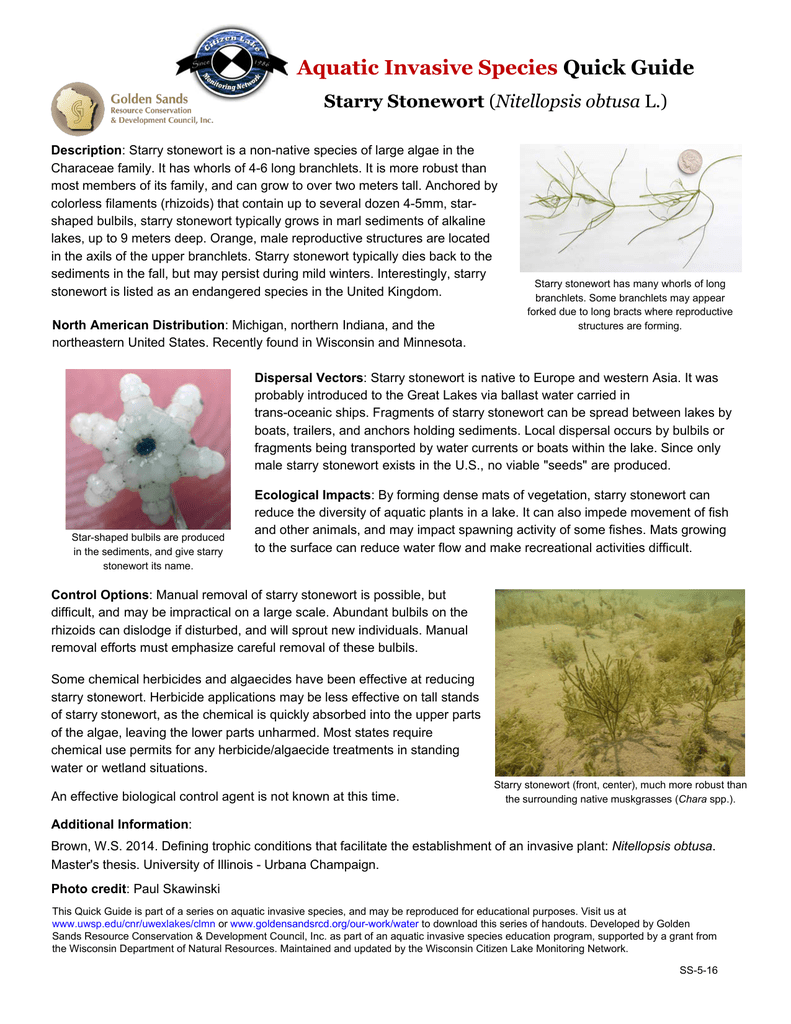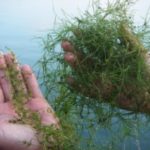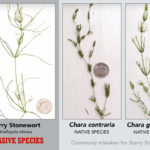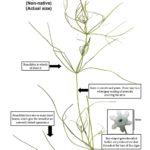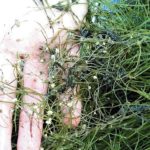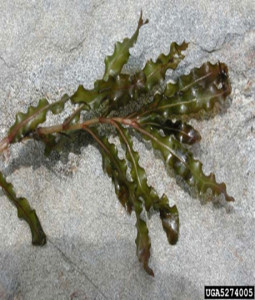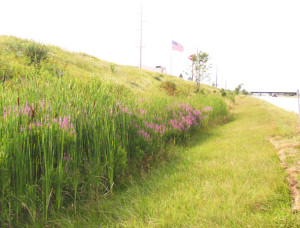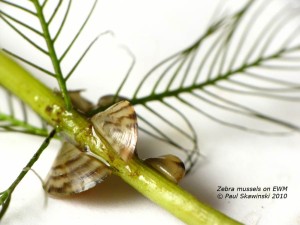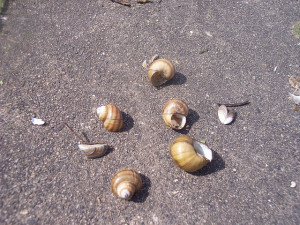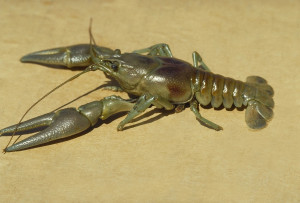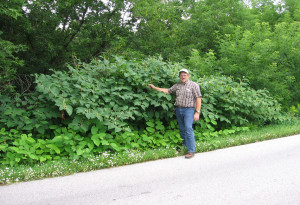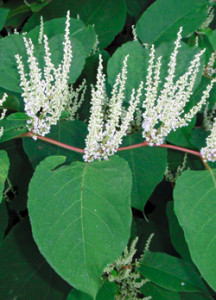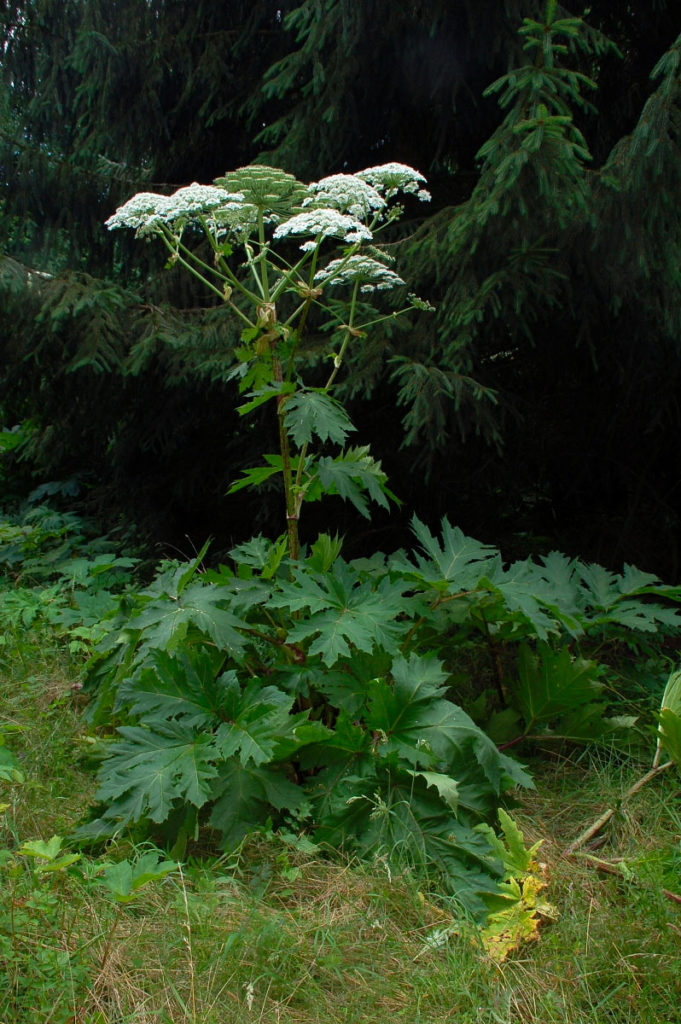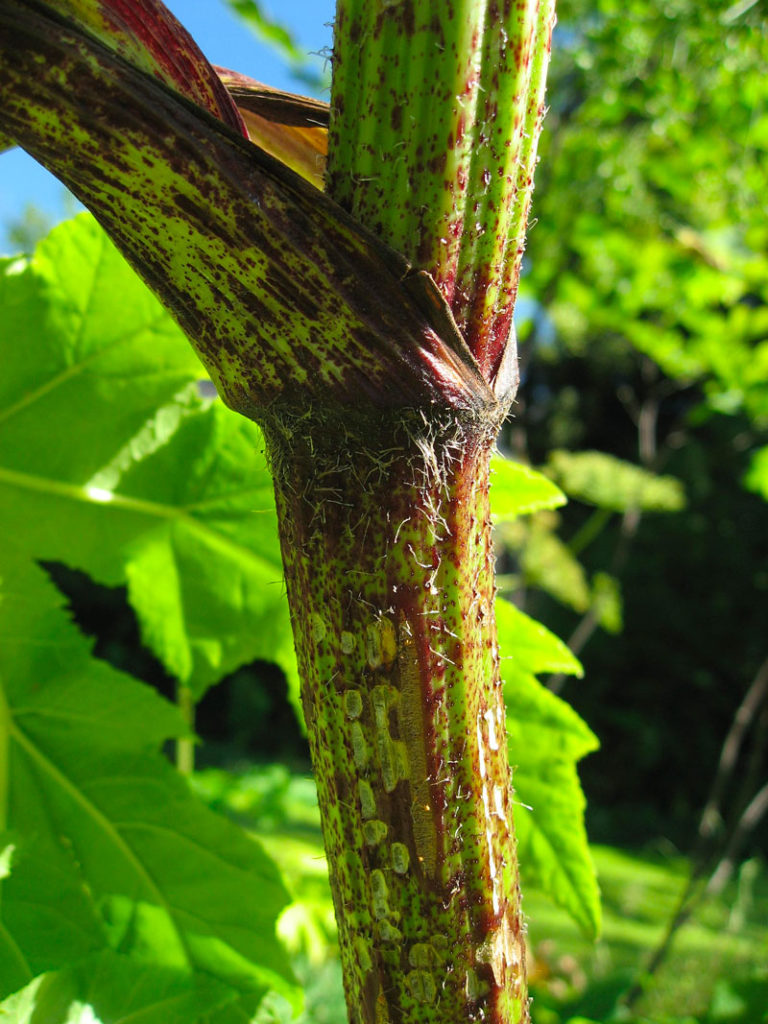Current list of all invasive species in Manitowoc County available on the Wisconsin DNR website.
Emerging Threat: The Starry Stonewort
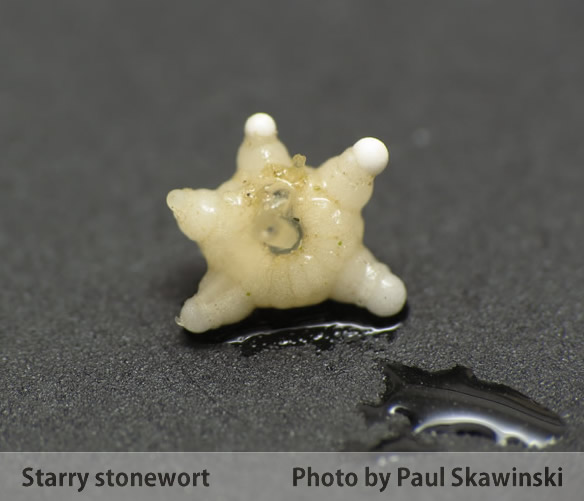
Starry Stonewort: This star-shaped submerged annual macroalga is known to cause nuisance conditions in MI, NY and IN.
DNR FAQ Sheet: https://dnr.wisconsin.gov/sites/default/files/topic/Invasives/ssw-faq.pdf
Description:
Leaves: Whorls of 4-6 branchlets (leaves) with blunt tips, irregular length branchlets are arranged along the main thallus (stem)
Fruits & seeds: Reproduction is via fragments or vegetative structures called “bulbils” which is the main identifying characteristic. Bulbils are produced at nodes and most are found on the rhizoids. These bulbils are 3-6 mm wide, star-shaped with 5 or more points. May produce orange-to-brown colored antheridia in branchlet axils.
Habitat: Lakes, rivers, reservoirs and ponds. Can grow in water depths up to 9 meters.
Chief Threat: It can outcompete other vegetation and forms monotypic stands that can reduce fish spawning habitat.It can reduce fish spawning habitats, outcompete other vegetation, and fragments can foul watercraft motors.
Method of Spread: Reproduction is via fragments or star-shaped vegetative structures called “bulbils” which is the main identifying characteristic.
Control methods: Current control methods have not been shown to have a measurable impact on starry stonewort. Special care should be taken to reduce the spread of starry stonewort within and amongst waterbodies, and to educate the public about presence if it is found.
For additional information and updates on Starry Stonewort, please visit the DNR website
Starry Stonewort Discoveries in Wisconsin
| Door County (6) | |||||
| Channel around High Cliff Park (Sturgeon Bay, WI) | 2016 | Details | |||
| Ellison Bay/Lake Michigan | 2016 | Details | |||
| Fish Creek (Green Bay) | 2016 | Details | |||
| Little Sturgeon Bay | 2016 | Details | |||
| Sister Bay/Green Bay Access | 2016 | Details | |||
| Sturgeon Bay | 2016 | Details | |||
| Kenosha County (1) | |||||
| Camp Lake | 2021 | Details | |||
| Marquette County (2) | |||||
| Kilby Lake | 2020 | Details | |||
| Lake Emery | 2019 | Details | |||
| Racine County (3) | |||||
| Lake Denoon | 2022 | Details | |||
| Long Lake | 2015 | Details | |||
| Wind Lake | 2017 | Details | |||
| Shawano County (1) | |||||
| Pine Lake | 2021 | Details | |||
| Walworth County (1) | |||||
| Geneva Lake | 2018 | Details | |||
| Washington County (5) | |||||
| Green Lake | 2016 | Details | |||
| Little Cedar Lake | 2018 | Details | |||
| Lucas Lake | 2022 | Details | |||
| Pike Lake | 2015 | Details | |||
| Silver Lake | 2015 | Details | |||
| Waukesha County (7) | |||||
| Big Muskego Lake | 2015 | Details | |||
| Lake Denoon | 2022 | Details | |||
| Little Muskego Lake (Initial Discovery in WI) |
2014 | Details | |||
| Lower Phantom | 2022 | Details | |||
| Nemahbin Lakes Boat Ramp | 2019 | Details | |||
| Okauchee Lake | 2019 | Details | |||
| Pewaukee Lake | 2019 | Details | |||
| Waupaca County (1) | |||||
| Miner Lake (Waupaca Chain of Lakes) | 2022 | Details | |||
| Lake Michigan (1) | |||||
| Lake Michigan – Rowleys Bay Access | 2016 | Details | |||
Below is a presentation on the current state of AIS threats including the Starry Stonewort in Manitowoc County by Samantha Lammers, Manitowoc County IS Coordinator:
More photos of Starry Stonewort:
Eurasian Water Milfoil (EWM) & Hybrid Eurasian/ Northern Water Milfoil
Pure Northern Water Milfoil is a species that is native to Wisconsin. Though it is a common plant in lakes, is not considered invasive.
Description: Greyish-green, finely divided pairs of fine, thin leaflets with a feathery appearance. Arranged in whorls of 3-6 leaves about the stem. Small, yellow or reddish flowers on a spike that projects 2-4 inches above the water surface. Winter-hardy.
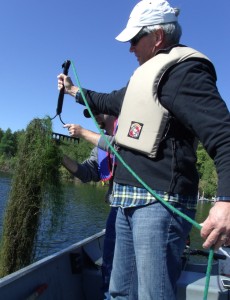
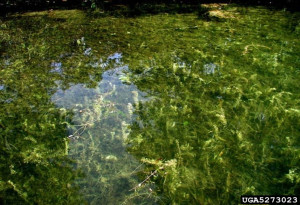 Chief threat: Forms surface mats that interfere with boating and fishing, reduce light penetration, thereby killing off native species. Eurasian Water Milfoil and EWM-NWM hybrids grow very quickly and can choke waterways, hampering boat access, fish passage, and water supply intakes.
Chief threat: Forms surface mats that interfere with boating and fishing, reduce light penetration, thereby killing off native species. Eurasian Water Milfoil and EWM-NWM hybrids grow very quickly and can choke waterways, hampering boat access, fish passage, and water supply intakes.
Habitat: Thrives in areas that have been subjected to natural and man-made disturbances. Over half of inland lakes in Wisconsin are affected. Identified in 25 water bodies in Manitowoc County. See the Wisconsin DNR page for a complete list.
Method of spread: Most regeneration is from rhizomes, fragmented stems, and axillary buds that develop throughout the year. The plants fragment easily, and fragments attached to watercraft can take root in un-infested lakes.
Control methods: Mechanical harvesting, raising or lowering water levels to drown or dehydrate plants, and chemical application by licensed individuals.
Control with Milfoil Weevil
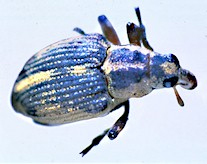
There has been some success in the treatment of EWM with the Milfoil Weevil. This native species has shown a preference for the invasive milfoil over the native milfoils.
What can you do? It is still being studied in some states but it is documented that the weevils do cause major set-backs in milfoil infestations. A robust population of the insects is a key to success. Augmentation of populations from laboratory cultures allows for greater reproductive success, but improving weevil habitat adjacent to the lake is a more direct intervention.
The milfoil weevil overwinters on land in leaf litter and soil, and then migrates back into the lake and begins its annual lifecycle in the beds of milfoil. There, the larvae hatch and grow, burrowing their way through the upper milfoil stems, causing the plants to weaken and die. As the weevil is a very poor flyer, it is essential that a good duff layer—decaying vegetable matter covering the ground under trees and the weevil’s requisite habitat—be adjacent to the lake to minimize the flight path. Lakefront property owners should maintain a well-vegetated setback.
Control by weevil would be compelling, given that chemical treatments to control EWM run $10-30K, may damage other aquatic species, and have also proven to be not all that effective. An investigative study in a Manitowoc County lake would be a valuable exercise. A good discussion can be viewed on the Illinois EPA website: http://www.epa.state.il.us/water/conservation/lake-notes/milfoil-weevil.pdf
Curly Leaf Pond Weed
Description: A perennial, submerged aquatic herb that is native to Eurasia. Tolerates fresh or slightly brackish water and can grow in shallow, deep, still, or flowing water. Thin, translucent leaves with wavy edges.
Habitat: Thrives in brackish water; tolerant of low-light and low-water conditions. Identified in Bullhead, Carstens, Cedar, English, Gass, Hartlaub, Horseshoe, Long (Big Long), Pigeon, West Twin, and Wilke Lakes. See the up-to-date list of infested lakes on the Wisconsin DNR website.
Chief threat: Forms large surface mats that interfere with boating and fishing. Causes increase in Phosphorous, which results in algae bloom.
Method of spread:
Control methods: Mechanical harvesting in early spring and chemical application by licensed individuals. Diquat, endothall, and floridone can be effective.
Purple Loosetrife
Description: Plants 3-7 feet tall in a dense bushy growth. Linear leaves and purple flowers that bloom in summer. Loosetrife has a woody root and a dense mat of rhizomes.
Habitat: A wide range of conditions. Preferred habitat includes sunny or partly shaded wetlands such as marshes, streams, and prairies. Can grow in drier conditions such as pastures and meadows. Widespread – can be found throughout Manitowoc County.
Chief threat: Quickly becomes dominant, forcing out natural vegetation and disrupting lake ecosystems. Degrades wildlife habitat. Can overrun open water habitat. Detrimental to water recreation, blocking waterways.
Method of spread: Seed spread in nature or on clothing, boats and equipment.
Method of control: Young plants and small infestations can be controlled by pulling if all root fragments are pulled. Dispose of plants and seeds in a landfill, or dry and burn them. DO NOT MOW. Clipped plants regrow, cut stems re-root. Many areas of the state use biocontrol Galerucella beetles that feed on the loosetrife. Can also be controlled with chemicals in late summer before flowering, consult a licensed aquatic herbicide application specialist and make sure that beetles are not in use in your area. Prevent spread: Rinse all equipment used in infested areas before moving into uninfested areas, including boats, trailers, clothing, and footwear. Remove new plants wherever you see them. Follow-up is essential for all invasive species control methods.
For additional information on purple loosestrife, visit the DNR website.
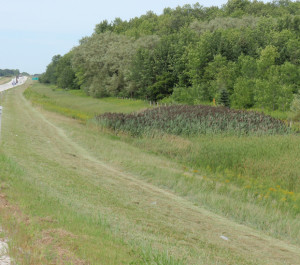
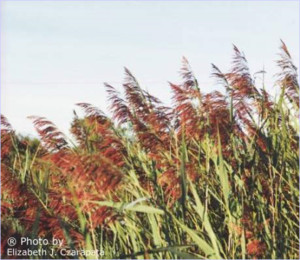 Phragmites
Phragmites
Description: Smooth, long, narrow blue-green leaves that are difficult to remove from stem, and stay on through winter. Bushy, light brown to purple feathery plumes that bloom July-September.
Habitat: Invades cattail marshes and critical habitats in flood plain wetlands.Tolerates a large range of water conditions, light levels and pH conditions. Established sites are widespread in Manitowoc County.
Chief threat: Shades native species, alters hydrology and wildlife habitat, increases fire potential and disrupts utility service.
Method of spread: Establishes deep and hardy root (rhizome) system underground, spread by transport of root fragments in soil and on equipment, also by above-ground runners and windblown seeds.
Control methods: Difficult to control. Methods include cutting, bundling, followed by chemical treatment by a certified applicator. Chemical use near water requires a permit.
Read more about Phragmites on the DNR website.
Read more about MCLA’s efforts toward Phragmites control in Manitowoc County.
Quagga mussels, zebra mussels
Description: Zebra mussels are tiny (1/8″ to 2″) freshwater clams with a yellow-brown D-shaped striped shell. Quagga mussels are slightly lighter in color, larger and more elongated.
Habitat: They are generally found in shallow, algae-rich water. Clusters of zebra mussels attach themselves to solid objects in the water, especially plant material. Zebra mussels also attach to the shells of native mussels, killing them. Quagga mussels are found in deep waters as well.
As of January 2017, Zebra mussels have been reported in Cedar Lake (verified 2001), Lake Michigan (verified 1991), Little Manitowoc River/Maritime Dr (observed 2015) and Pigeon Lake (verified 2007).
In summer of 2015, the DNR conducted an invasive species of the Rockville flowage located just east of the city of Kiel and identified the larvae stage of Zebra mussels. Part of the survey includes a tow net pulled behind the boat that filters lake water as it is being towed. The filtered material is later analyzed in the lab for the larval stage of Zebra and Quagga mussels called veligers. Lake residents are requested to contact tomward@tm.net if adult Zebra mussels are found.
See the WI DNR page for up-to-date lists of Manitowoc County lakes with reported infestations: Zebra Mussels
Chief threat: Invasive mussels filter and eat good algae, phytoplankton, depleting native fish of food directly and indirectly. This filtration leads to higher light penetration and thicker plant growth, which interferes with lake recreation. Zebra mussels promote the growth of blue-green algae, since they do not eat it.
Method of Spread: Quagga mussels and zebra mussels spread in the same ways. Through recreational lake activities. They reproduce rapidly and the larvae are carried in live wells and bilge water on boats, and in bait buckets. They attach themselves to boat hulls and trailers and stick to vegetation that may be caught on recreational equipment.
Control methods: Prevention is Key! Once zebra mussels are established in a water body, very little can be done to control them. Inspect and remove aquatic plants, animals, and mud from the boat and equipment before leaving the boat launch. Drain water from your boat and equipment before leaving the boat launch. Throw away unwanted bait. Remove all plant materials from your boats and trailers. Spray or rinse your boat and equipment with high pressure or hot tap water, especially if moored for more than a day, or, dry your boat and equipment completely for at least 5 days. Chemical applications include solutions of chlorine, bromine, potassium permanganate and even oxygen deprivation.
Read more about invasive species of zebra mussels and quagga mussels on the DNR website.
Spiny Water Flea
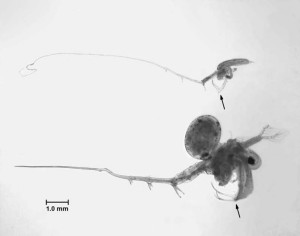
Microphotograph taken by J. Liebig, NOAA GLERL, 2001. Source: http://www.glerl.noaa.gov/pubs/photogallery/Waterlife/pages/1017.html
Description: Spiny waterfleas are only about ¼ to ½ inches in length and translucent, so individual waterfleas usually go unnoticed. However, they gather in masses on fishing lines; anglers are key to reporting new infestations.
Habitat: Fish hook and spiny waterfleas have been a problem in Lake Michigan for quite a while. They have been found in water bodies in Vilas County, and Lake Mendota and Lake Monona in Dane County. See this DNR page for reports of infestations in Wisconsin Lakes.
Chief threat: These water fleas are a direct and indirect threat to young fish. They eat zooplankton, putting them in direct competition with juvenile fish for food. Their long spiny tail can kill young fish that try to eat them by piercing the stomach.
Method of spread: Threat is spread by Lake Michigan watercraft and recreational equipment visiting inland lakes and discharging bilge and live well water. Old, dried eggs on watercraft could be viable if re-introduced to water. They reproduce rapidly.
Control methods: Great care must be taken not to transport water between water bodies and to remove all waterfleas and eggs from all equipment.
Banded Mystery Snail
Description: Banded mystery snails are non-native snails that are found in an increasing number of Wisconsin lakes. The mystery snail’s large size (1″) and hard operculum (cover that protects the soft flesh), and their thick hard shell make them less edible by predators such as rusty crayfish. This snail is found in lakes and slow-moving rivers with mud bottoms. The species thrives in eutrophic lentic environments such as lakes, ponds and some low-flow streams.
Habitat: Any water body. Reported in Bullhead, Cedar, English, Pigeon, Spring and Tuma Lakes. See this DNR page for current reports of infestations in Manitowoc County.
Chief threat: There is not a lot yet known about these species, but they have a negative effect on native snail populations. Piles of dead snail shells litter beaches making them unpleasant.
Method of spread: Watercraft and recreational equipment.
Control methods: Clean all boats and equipment before leaving a water body. It’s the only way to prevent transport of these and other threats. It’s not just a good idea, it’s the law.
Rusty Crayfish
Description: This crayfish measures two and one-half inches (not including claws) in length. They have large claws with black bands on the tips and dark, rusty spots on each side of their body. Their claws are grayish-green to reddish-brown and smoother than most other crayfish. The rusty spots may not always be present or well developed on rusty crayfish from some waters.
Habitat: Rivers, streams, and other water bodies. Reported in Silver Lake. See the Wisconsin DNR’s list of Manitowoc County lakes where Rusty Crayfish have been found.
Chief threat: Outside their home range, rusty crayfish are likely to displace native crayfish and reduce aquatic plant abundance and diversity. In some northern Wisconsin lakes it has eaten most of the aquatic plants, hurting the quality of the lakes. Aquatic plants provide important habitat for fish and other aquatic animals, as well as prevent erosion. By damaging underwater habitat, fish also lose their spawning areas, protective cover, and food. Fish that normally eat crayfish don’t like the feisty, aggressive “rusty.” It takes over the homes of native crayfish and has been known to eat fish eggs. Rusty crayfish reproduce quickly and females lay from 80-575 eggs!
Method of spread: Illegal use of crayfish as bait. Transporting in bilge water and on equipment.
Control methods: Intensive harvest will not eradicate crayfish, but may help reduce adult populations and minimize some impacts. Although there are chemicals that will kill crayfish, there are no chemicals available to eradicate only rusty crayfish. The best method of control, however, is to prevent their introduction:
- Inspect and remove aquatic plants, animals, and mud from the boat and equipment before leaving the boat launch
- Drain water from your boat and equipment before leaving the boat launch
- Throw away unwanted bait in the trash
- Spray or rinse your boat and equipment with high pressure and/or hot tap water, especially if moored for more than a day, or, dry your boat and equipment completely for at least 5 days
- Do NOT use crayfish as bait, it is against the law in Wisconsin
Viral Hemorrhagic Septicemia (VHS):
Test results from 2006 to 2012 show that VHS has only been detected in fish from the Lake Winnebago system, Lake Superior, Lake Michigan, and Green Bay, and hasn’t spread more widely in Wisconsin, as originally feared. Those results suggest there’s a very real hope that VHS can be kept out of most of Wisconsin’s lakes and rivers, where it could prove a serious threat to a broad range of native fish. Please familiarize yourself with the signs of VHS and report any suspected fish.
Viral Hemorrhagic Septicemia (VHS) is a deadly fish virus that was first discovered in Lake Winnebago in 2006. It’s not a threat to people who handle infected fish or want to eat their catch, but it is threat to a variety of fish species. It is very important that everyone do their part to prevent the spread of VHS and help keep Wisconsin’s waters healthy. This virus, first found in the Great Lakes, kills more than 25 species of fish, including many popular game fish including these popular Manitowoc county fish and others:
- Largemouth bass, Smallmouth bass, White bass
- Black crappie
- Brown bullhead
- Chinook salmon
- Emerald shiner, Spottail shiner
- Muskellunge
- Northern Pike
- Yellow perch
- Sunfish: Pumpkinseed, Bluegill, Rock bass
- Brown trout, Rainbow trout
- Walleye
Signs a fish might have VHS
The following symptoms could apply to many different fish diseases, therefore, VHS must be confirmed by lab tests. Additionally, some infected fish may not show any signs and transporting these fish to new locations could spread the disease to new waters.
- Hemorrhaging (bleeding)
- Bulging eyes
- Unusual behavior
- Anemia; pale organs
- Bloated abdomens
- Rapid onset of death
Reporting diseased fish
If you catch a diseased fish or observe a fish kill take the following steps:
- Note the waterbody, date, fish species, and approximate number of dead/dying fish
- If you caught a suspicious looking fish, place the fish in a plastic bag and then in a cooler on ice
- Contact your local fisheries biologist or call the DNR TIP line – 1-800-TIP-Wisconsin DNR – (800) 847-9367
- DO NOT BRING POTENTIALLY DISEASED FISH TO DNR SERVICE STATIONS OR HATCHERIES
- DO NOT COLLECT FISH SAMPLES FROM A FISH KILL
- The local fisheries biologist will contact you as soon as they are available and will make the determination about whether the fish should be examined or not.
- We are encouraging anglers to retain suspicious looking fish as part of their daily bag limit for examination by the local fisheries biologist.
- The DNR is limited by staff time, financial resources, and laboratory capacity for VHS testing. Therefore, we must prioritize which fish/fish kills we examine in order to ensure that the most likely cases are examined and tested before the less likely ones. Our staff will not have time to visit every occurrence of dead fish or examine every potentially diseased caught fish.
Your understanding and assistance in this matter is greatly appreciated.
Other Invasives in Manitowoc County
Japanese Knotweed
Description: Perennials with large green leaves. 5-10 feet tall in large clones up to several acres. The hollow bamboo-like stems are reddish brown and remain upright through winter; leaves drop in fall. Two-inch-long clusters of white flowers bloom in summer.
Habitat: Tolerates a variety of habitats, many soil types and a range of moisture conditions.
Chief threat: Invades wetland areas, crowding out native vegetation and leaving banks vulnerable to erosion when the knotweed drops its leaves in winter. Root system is strong enough to damage pavement and penetrate building foundations.
Method of spread: Can reproduce by seed but primary method is through movement of its rhizomes; fragments transported in streams, in fill dirt, on equipment, or by roadside mowing.
Control methods: Pulling or digging is generally ineffective. Herbicide application is effective when treated repeatedly. Follow-up for a few years is required.
For additional information on Japanese knotweed, visit the DNR website.
Giant Hogweed
Description: Giant hogweed reaches up to 8-20’ and has hollow, ridged stems covered in coarse white hairs and reddish-purple mottling. Grows as a lowing-laying bushy rosette for at least the first year. Will bolt in the second year based on maturation and grow to be 8-20’ tall. The plant dies after seed dispersal.
Habitat: Giant hogweed grows in wet areas along streams and rivers, on waste ground, near houses, in vacant lots, and along railways and roads. It prefers moist soil.
Chief threat: Invades roadsides, empty lots and woodland edges. Can crowd out native vegetation. Along stream banks, it can lead to soil erosion and disperse seeds downstream. Sap from leaves and stems can cause a phytophotodermatitic reaction on skin, when exposed to sunlight, consisting of severe burns and blisters.
Method of spread: Giant hogweed seeds can be dispersed short distances by wind and long distances by moving water.
Control methods:
Mechanical: Small populations can be hand-dug. Use a sharp shovel to cut 1-2” below soil surface before seeds set. Burn flowering heads or bag for landfills. *Caution: Sap exposure from leaves and stems onto direct skin can cause a phytophotodermatitic reaction consisting of severe burns and blisters.
Chemical: Glyphosate (LR), 2.5% a.i., triclopyr, or metsulfron methyl (1.5oz per gallon) is effective as foliar sprays or on cut stems.
For additional information on Giant Hogweed, visit the DNR website.
Common Teasel
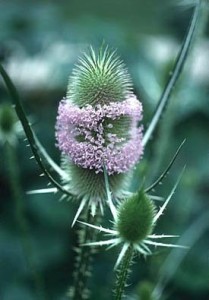 Description: 2-6′ tall plant with deep tap root. Large (up to 1.5’ long), oblong, and prickly leaves. Hundreds of small flowers, clustered in dense, egg-shaped heads. Stiff, spiny, leaf-like bracts curve up from base of flower head. Common teasel has purple flowers and bracts longer than the flower heads. Commonly blooms from June-October. Each plant can produce as many as 2,000 seeds. Seeds remain viable in the soil for at least 2 years!! Similar species: Cut-leaved teasel leaves are broader and have deep, feathering lobes. Its bracts are shorter than the flower heads. The flowers are white and bloom from July-September.
Description: 2-6′ tall plant with deep tap root. Large (up to 1.5’ long), oblong, and prickly leaves. Hundreds of small flowers, clustered in dense, egg-shaped heads. Stiff, spiny, leaf-like bracts curve up from base of flower head. Common teasel has purple flowers and bracts longer than the flower heads. Commonly blooms from June-October. Each plant can produce as many as 2,000 seeds. Seeds remain viable in the soil for at least 2 years!! Similar species: Cut-leaved teasel leaves are broader and have deep, feathering lobes. Its bracts are shorter than the flower heads. The flowers are white and bloom from July-September.
Habitat: Invades open areas, prairies, savannas, and sedge meadows, as well as roadsides and disturbed areas.
Chief threat: Displaces native species.
Method of spread: By seed. Rapid range expansion of cut-leaved teasel has been observed in several Midwestern states.
Control methods: Rosettes can be dug up making sure to remove as much of the root as possible. Mature plants can be cut in full bud stage; plant will re-sprout but will not flower. Bag and dispose of stems. Late spring burns. Foliar spray with triclopyr, clopyralid, aminopyralid, or metsulfuron before plant has bolted. Spray rosettes in fall with glyphosate.
Emerald Ash Borer
- Kiss your Ash Goodbye by Tom Ward, AIS Coordinator, July 2016 for information on what homeowners and land owners can do to prepare for the loss of our Ash population.

